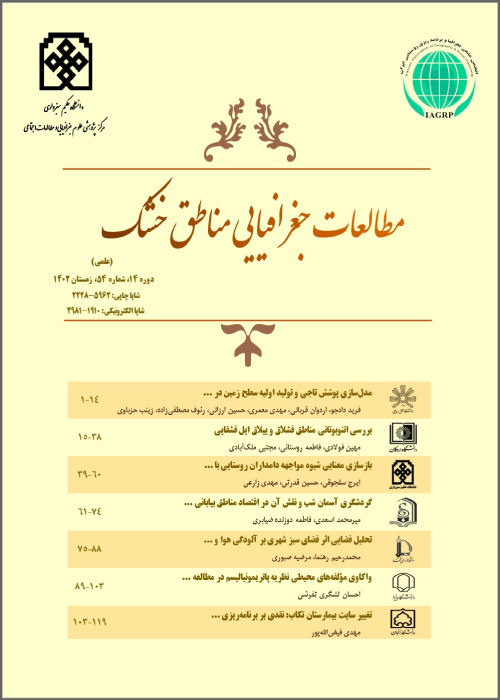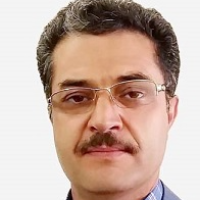Analyzing the Role of Urban Land Policies on Urban Sprawl (case study: Sabzevar)
Author(s):
Article Type:
Research/Original Article (دارای رتبه معتبر)
Abstract:
Introduction
Urban sprawl is considered as one of the well-known patterns of urban expansion, which means uncontrolled physical expansion of cities on agricultural land or undeveloped surrounding areas. What today is known as sprawl describes scattered and low-density urban expansion. Patterns of urban sprawl expansion could have adverse consequences, such as increasing share of open spaces and urban fragmentation, reducing population density and social segregation, inefficient use of land and imposing staggering costs on urban infrastructure, eradication of farms and the environment, increasing the demand for cars and consequently increasing air pollution and reduced social interaction. Land use planning is necessary to control and reduce the negative impacts of this type of expansion.
One of the factors affecting the physical expansion of urban sprawl is land and housing policy at national and local level that is applied in the form of assignment of state lands to build residential and industrial estates, policy on agricultural land use change to residential area, determine building density and pattern of urban land fragmentation.The main objective of this study is to evaluate the role of land policies on the urban sprawl expansion in Sabzevar, Iran, in the past few decades.
Materials and Methods
In the present descriptive-analytical research, data required were collected mainly through documents from various organizations and analyzed using quantitative models like Holdren and Entropy methods. In addition, maps for physical expansion and growth in different previous periods were prepared to demonstrate the expansion of the city in graphical form using existing maps and aerial photos or satellite images via Arc GIS software.Discussion and Results
The city of Sabzevar in the last half century under the influence of natural population growth and migration of villagers with varying degrees of intensity in different periods has seen dramatic growth of the population, so that the population of Sabzevar has been 7.98 times from 1956 to 2016. In contrast, the area of the city has been growing faster than its population, so that its area has been equal to 18.15 times in the same period. This imbalance between population growth and the area in each period indicates the predominance of horizontal growth and urban sprawl. Comparison of increasing the urban area and the state land assigned areas show that a total of 2959 hectares added to Sabzevar between 1956 and 2016 have been about 31.55% because of the land assignment policy and 19.13% the result of informal settlements and villages annexed to the city. The most important thing about this area is that almost 100% of these lands are in areas that have been assigned directly by the government, or have been prepared by the government, and then assigned to the residents. Thus, the highest rate of urban sprawl can be seen in the directions that the government has had a direct role in its establishment. Therefore, the land assignment policy by allocating around 40% of the area added to the city limits has acted as the most important factor in the physical expansion of the city of Sabzevar.The results of the calculations of the Holdren model demonstrated that population growth from 1956 to 1986 had a larger share in the urban area changes, so that the share of population changes in the period of 1976 to 1986 was achieved 98% and 0.02 per capita share of changes. However, this trend in the two next periods, i.e. 1986 to 1996 and 1996 to 2016 has been reversed and the share of changes per capita has surpassed the share of population changes. In the period of 1986 to 1996, per capita share was 68% versus 32% population changes and in the period of 1996 to 2016 was 59% versus 41%. This is due to the impact of land attached to the city through the lands vested in the form of land preparation project in Tohidshar and the incorporation of surrounding villages, including Kelate Sifer, Saleh Abad and Ghalee No Dehraz.
Conclusions
Investigate the process of changes and patterns of urban physical expansion, and identify and analyze the effective factors are important for two reasons. Firstly, urban scattered and uncontrolled horizontal growth leave the inevitable consequences and sometimes undesirable on the economic, social and ecological aspects of the city. Secondly, analysis of the physical expansion process helps to more accurate planning to control and systematic guidance of expansion. Among the factors affecting the horizontal growth of the city of Sabzevar in the past few decades, land and housing policies have had a significant role in the city's physical expansion in certain directions. Thus, about 40% of the area added to the city in the last half century has been caused by the state land assignment policy. Discontinuous tissue formation in Tohid town was one of the obvious consequences of the policy that took place followed by the land assignment in the preparation project.The assignment of the lands that took place in relatively large segmentations with an area of 250 square meters on average affected the physical expansion and construction of the city in the past two decades in several ways.
Firstly, this policy accelerated the horizontal expansion than the population growth. Secondly, the fact that these lands have been usually fragmented to regular segmentation and with predicted access network, urban expansion on these lands has a regular and chess-like form. Thirdly, the land assignment policies, particularly in the preparation project, led to the establishment of a new pattern of physical expansion in the form of urban discontinuous expansion, which can identify outlines for future expansion of the city.
In addition to the factors mentioned above, the annexation of villages and illegal settlements to the urban area in recent decades has had a significant impact on the direction and extent of physical growth of Sabzevar .
Keywords:
Language:
Persian
Published:
Arid regions Geographic Studies, Volume:8 Issue: 30, 2017
Pages:
45 to 60
magiran.com/p2011293
دانلود و مطالعه متن این مقاله با یکی از روشهای زیر امکان پذیر است:
اشتراک شخصی
با عضویت و پرداخت آنلاین حق اشتراک یکساله به مبلغ 1,390,000ريال میتوانید 70 عنوان مطلب دانلود کنید!
اشتراک سازمانی
به کتابخانه دانشگاه یا محل کار خود پیشنهاد کنید تا اشتراک سازمانی این پایگاه را برای دسترسی نامحدود همه کاربران به متن مطالب تهیه نمایند!
توجه!
- حق عضویت دریافتی صرف حمایت از نشریات عضو و نگهداری، تکمیل و توسعه مگیران میشود.
- پرداخت حق اشتراک و دانلود مقالات اجازه بازنشر آن در سایر رسانههای چاپی و دیجیتال را به کاربر نمیدهد.
In order to view content subscription is required
Personal subscription
Subscribe magiran.com for 70 € euros via PayPal and download 70 articles during a year.
Organization subscription
Please contact us to subscribe your university or library for unlimited access!



